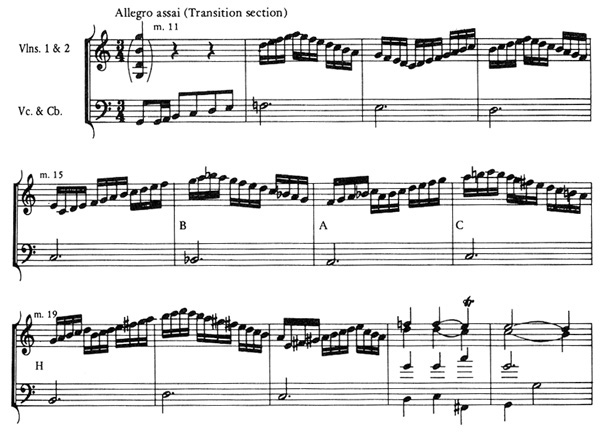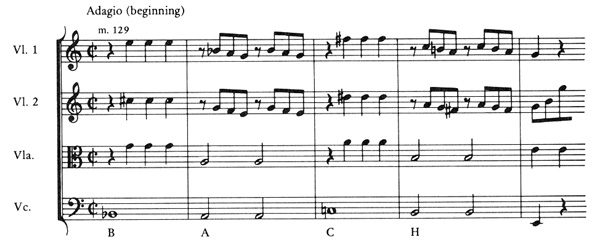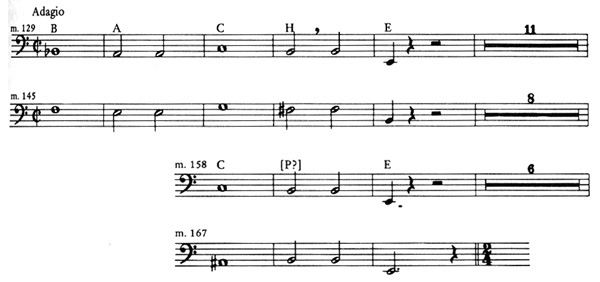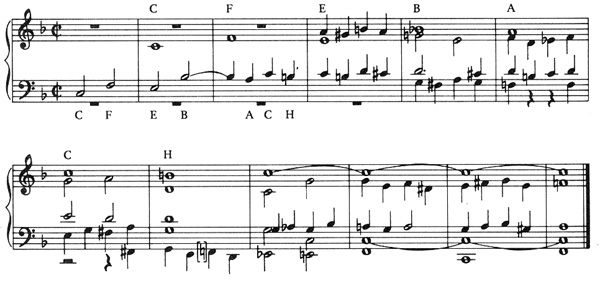I was taping of copy of Emanuel Bach's Symphony in C for classroom use. It was a hot day and the door to my office was open. Before two dozen measures had sounded, a jovial colleague1 put his head in and proclaimed, "Aha, Bach!"
"Do you know the piece?" I asked.
"No," he replied, "but I can spell B-A-C-H when I hear it."
The score confirmed for me what my friend's perfect pitch had told him: the series of measure-long bass notes B-flat, A, C and B-natural which in German nomenclature spell the name of Bach. However, the four-note phrase occupied a position that prompted us to shrug it off as an amusing coincidence. Since then a closer examination of the score has made that judgment appear too hasty.
Carl Philipp Emanuel Bach's Symphony in C2 belongs to the set of six "Hamburg" symphonies, W. 182, composed in 1773 for Baron Gottfried van Swieten.3 Like the others in the set, this one consists of three movements in contrasting tempos, in this case an Allegro assai in C Major continuous with an Adagio in E Minor, followed by the concluding Allegretto in C Major. It is a buoyant but temperamental symphony, mingling flashes of fire with touches of sentiment in a declamatory flow that artfully conceals its neatly poised structure. Jan LaRue used to tell his students that they could usually expect to find in compositions by C.P.E. Bach at very least "one eloquent moment," one passage of particularly expressive intensity. The most striking of such moments in our symphony occurs when the Allegro's mercurial progress toward a natural conclusion is impetuously interrupted by the poignant E Minor Adagio, binding the pair into a single musical construction.
The opening movement follows the general procedures of a sonata-allegro4 in which the opening of the primary motive (P) permeates most of the other themes of the exposition. The four notes that spell the name BACH occur in the exposition as a part of the accompaniment to a brilliant flourish of sixteenth notes during the transition from the primary to the secondary tonality (Ex. 1).
Ex. 1. C.P.E. Bach, Sinfonia in C, W. 182 [3], Mvt. I.

They do not seem to stand out especially from their background, occupying as they do the fifth through the eighth measures of a ten-measure passage. Still it is true that they do begin the second four-measure group of a passage with the structure:
| (2 + 2) | + | (2 + 2) | + | 2 | ||
| BACH |
and that the B-flat catches the ear as the first note in the passage to depart from the key of C. Nevertheless, these features do not seem to justify reading a special significance into those four notes. Moreover, the same transition passage occurs in the recapitulation, this time transposed up a perfect fourth, so that instead of BACH the four notes now spell the meaningless configuration: E-flat, D, F, E. This second appearance of the bass melody (transposed, but in precisely the same musical context as before) seems to confirm the impression that their initial appearance was no more than a coincidence. However, they will occur again.
They return at just that point described earlier as the most eloquent moment in the symphony (Ex. 2), the point at which the Adagio, with its sudden change of tempo, meter, key, and mood, seems to thwart the conclusion of the Allegro.
Ex. 2. C.P.E. Bach, Sinfonia in C, W. 182 [3], Mvt. II.

Here a fortissimo B-flat intrudes in place of the expected C and continues to spell, again with one pitch to a measure, B-flat, A, C, B-natural (BACH). These four measures constitute the structural and dramatic fulcrum of the paired movements. Each of the four notes begins alone, while the remaining voices wait on empty downbeats. The emotionally-charged moment calls forth that most fearsome harmony in the classical vocabulary, the diminished seventh, to force a path from C Major to E Minor by way of the unprepared B-flat. If Emanuel Bach wanted an arresting setting in which to encode his name, he could not have chosen a more appropriate or more characteristic one. There can be little doubt about the monogram in these measures of the Adagio; at least one other writer noticed them before me.5
In the second movement, as in the first, the four notes return in almost the same context but transposed this time up a perfect fifth (= down a fourth: F, E, G, F-sharp) as if to balance the design of the Allegro. The symmetry thus created dispels any suspicion of coincidence governing the appearance of the name in the first movement as well.
The Adagio is set mainly in a three-part texture for violins and viola. The cello and bass play for a total of only thirteen and a half measures of the 41-measure movement (Ex. 3).
Ex. 3. C.P.E. Bach, Sinfonia in C, W. 182 [no. 3]: The complete bass of the Second Movement.

The first two passages sound the Bach motive (in loco and transposed); the last two supply cadences to E Minor. The first of those cadences, C, B-natural, E can be forced to represent the initials C.P.E. (with an eye to the parallel structures in the bass part as a whole) but only at the expense of some specious numerological juggling.6 Indeed, as we shall see in the letter discussed below, the composer seems to have been aware of the difficulty raised by the unmusical initial P of his second given name. The E Minor tonality of the Adagio could very well have been intended to represent the initial of Emanuel in a movement that opens with the explicit spelling of BACH. In any event the fact that the bass part of the Adagio rests throughout most of its length lends greater emphasis to the few notes that it actually does play. Therefore the weight of stylistic evidence favors the thesis that the BACH at the beginning of the Adagio is, in fact, intentionally symbolic; if we accept that instance, must we not place the same interpretation on the three other occurrences of the melody?7
To a letter of 28 April 17848 Emanuel Bach appended a postscript that clearly continues a discussion begun in earlier correspondence. After concluding the letter, which is concerned with totally different business, he begins without preamble:
Recently someone wrote to me that it was remarkable that not merely my family name but the initials of my given names (all' italiano), C.F.E., were also musical. Thereupon I replied:
Ex. 4. C.P.E. Bach, [Canonic postscript], after Bitter.

I have not yet attempted to work [it as] a rondeau into a concerto.9
The dense chromaticism of the little canon seems to lend it just a tinge of good-natured parody of Emanuel's own Empfindsamkeit. The tone of the postscript makes it clear that such monograms were known outside the circle of the Bach family.10 The wording of the postscript shows clearly that while Emanuel may not have considered the possibility of encoding his given initials all'italiano, he did know already—and his correspondent also knew—that Bach was a "musicable" name. That was in 1784, eleven years after our sinfonia.
The final, indeed, the most persuasive argument in favor of our interpretation of the C Major sinfonia emerges when we recall that it was Emanuel Bach who entered the well-known annotation in the manuscript of his father's Art of the Fugue: "While working on this fugue, where the name BACH enters in the countersubject, the composer died."11
Emanuel's annotation bears no date, but it must have formed the basis for the notice of the same import printed on the reverse of the title page of the first edition of the Art of the Fugue in 1751.12 In the second edition (1752) a preface by Marpurg replaced that notice at the request of "the esteemed heirs of the late Capellmeister Bach"13—presumably Emanuel and his brother Wilhelm Friedemann, to both of whom Marpurg dedicated the second part of his Treatise on the Fugue (1754).14 It was probably Emanuel who saw to the publication of the Art of the Fugue.15 By 1756 it was Emanuel who offered the plates of the publication for sale.16 Given these circumstances we have no reason to imagine Emanuel impatiently disposing of the plates in 1756 and later returning to the manuscript to make an annotation giving information previously printed in the first edition. It is far more reasonable to regard the manuscript's annotation as the basis for the printed notice—that is the most normal sequence—and to place it in the period before the publication of the first edition in 1751.
While our speculations about the initials C.P.E. have led us to nothing solid, the same is not true of the central theme of this article: the validity of the monogram at the striking opening of the Adagio and its reflections in other parts of the first two movements. Emanuel knew the monogram at least as early as the 1750's (indeed, might he not have learned it from his father?)17 and knew it in 1784 ("nicht allein mein Zuname, sondern auch . . . C.F.E."); surely its occurrence in a work of 1773 can hardly have been by accident. It was Emanuel who first called our attention to the famous musical signature. He was evidently familiar with the device, and as we have seen, perfectly capable of adapting it to his own creative and expressive purposes.
APPENDIX
The following observations are offered for the reader's speculation, but without any hint of advocacy by the author.
One indication of Emanuel's preoccupation with names appears in his brief keyboard pieces, some of which he named after ladies. Among them we find La Caroline, and La Philippine, but no Emanueline. He probably wrote these for his daughter Anna Carolina Philippina, or for her god-parents—but we have no L'Anna either.
Emanuel's father seems to have been interested in the fact that two versions of his names were numerological reflections of each other: BACH = 14, J.S. BACH = 41 (when I and J count as the same letter), and 14 is the reverse of 41. It can be no more than a coincidence that the second movement of our symphony is 41 measures long, and that the total length of the bass part (see Ex. 3) in actual note durations is thirteen and a half measures, i.e. into the fourteenth measure.
Alfred Wotquenne, Thematisches Verzeichnis der Werke von Carl Philipp Emanuel Bach (Leipzig, 1905; reprint Wiesbaden, 1964), p. 62, lists the keys of the six Hamburg symphonies in the order G, B-flat, C, A, B-natural, E. If we apply the conventionally correct version of the numerological method discussed above (see footnote 6) thus:
| A | B | C | D | E | F | G | H |
| I/J | K | L | M | N | O | P | Q |
then G = P; and if it were permissible to treat those keys as an anagram, we could re-order them to form P.E. BACH. While this proceeding is obviously very arbitrary, it should be noted that the letters B, A, C, and H are in fact present among the keys.
The name of Bach may be extracted with even smaller confidence from passages in another set of Emanuel's symphonies, those of W. 183 (Das Erbe deutscher Musik, 1. Reihe: Reichsdenkmale, vol. 18, ed. R. Steglich, Leipzig, 1942). In the first of those symphonies, measures 51-56 in the first movement (pp. 6-7), the first flute plays a series of long, exposed notes: C, B-flat, A, C, B-natural. Although these notes are fairly prominent, three factors argue against their symbolic interpretation. First, their irregular durations (expressed here as numbers of quarter notes, viz., 8, 8, 3, 9, 1/2) do not create a thematic shape. Second, the prominence of the first note, C, gives it more weight than the more characteristic notes that follow it. Finally, the brevity of the final B-natural makes it all but disappear in the onset of the next phrase.
An even less persuasive instance appears in the third symphony of the same set, measures 19-20 in the first movement (op. cit., p. 57); here the first flute plays the name, but in retrograde. Neither of the two preceding examples receives confirmation elsewhere in their respective symphonies.
This writer regards none of the foregoing examples as persuasive. Their chief value resides in the contrast they offer to the controlled, orderly, and analytically confirmed occurrences in our C Major sinfonia.
1Dr. Dominic Intili, Music Department, Indiana University of Pennsylvania.
2Nagels Musik-Archiv, no. 73, edited by E.F. Schmid (Hanover, 1931).
3Karl Geiringer, The Bach Family (New York, 1954), p. 368.
4Exposition—P: 1-11; T: 11-23: 1S: 24-27; 2S: 28-35; 3S: 35-43; K: 43-56. A false recapitulation in F begins at measure 69, but only the third part of S (3S) becomes rationalized in the tonic.
5As I learned later. Ernst Suchalla, Die Orchestersinfonien Carl Philipp Emanuel Bachs nebst einem thematischen Verzeichnis seiner Orchesterwerke (Diss. Mainz, 1968; Augsburg, 1968), pp. 80-81, cites the monogram in passing and suggests that Emanuel may have intended it as a greeting to Gottfried van Swieten, the patron of these symphonies. Suchalla does not take up the implications of the monogram.
6Counting I and J as separate letters, thus
A B C D E F G H I J K L M N O P
B-natural = P. However, since Emanuel's father counted I and J as same letter, we may question the propriety of this method.
7It is far from clear whether additional monograms lie concealed in Emanuel's work. See the appendix to this article.
8Printed in C.H. Bitter's Carl Philipp Emanuel und Wilhelm Friedemann Bach und deren Brüder (Berlin, 1868), II, 303-4. Bitter's source was a copy made by Zelter in 1820 of Emanuel's letter to the Greifswald advocate Grave. Suchalla, loc. cit., quotes the first part of the postscript and the name-notes in the treble staff.
9Translation mine. Rachel Wade, who is completing a dissertation on C.P.E. Bach, is almost certainly correct in her opinion (private communication) that the curious last sentence of the postscript refers to other business. I owe thanks to Ms. Wade for several courtesies which have benefited this paper. The German text runs, Jüngst schrieb mir jemand, es etwas besonderes sey, nicht allein mein Zuname, sondern auch die Anfangs-buchstaben meines Vornames (all'italiano) C.F.E. wären musikalisch. Hierauf antwortete ich. [The music appears here.] In einem Concerte ein Rondeau anzubringen habe ich noch nicht versucht.
10The monograms bear an obvious similarity to the solmization-based soggetto cavato dalle vocali of the Renaissance.
11For facsimiles of this page see Walter Gerstenberg, Musikerhandschriften (Zurich, 1960), plate 70, and Hans T. David and Arthur Mendel, The Bach Reader (New York, 1945; rev. 1966), facing p. 256.
12David and Mendel, op. cit., p. 198.
13Ibid., p. 266 ff.
14Ibid., p. 254 f.
15Christoph Wolff, "Johann Sebastian Bach" in The New Grove's Dictionary of Music and Musicians, 6th ed. (London, 1979).
16David and Mendel, op. cit., p. 269.
17Emanuel may even have known about the monogram before 1732 when J.G. Walther reported it as the discovery of J.S. Bach in the Musikalisches Lexikon (Leipzig, 1732), p. 64, in facsimile edition Documenta Musicologica, Erste Reihe: Druckschriften-Facsimiles, III (Kassel and Basel, 1953).


